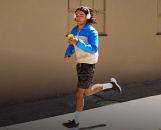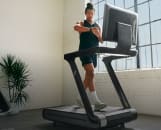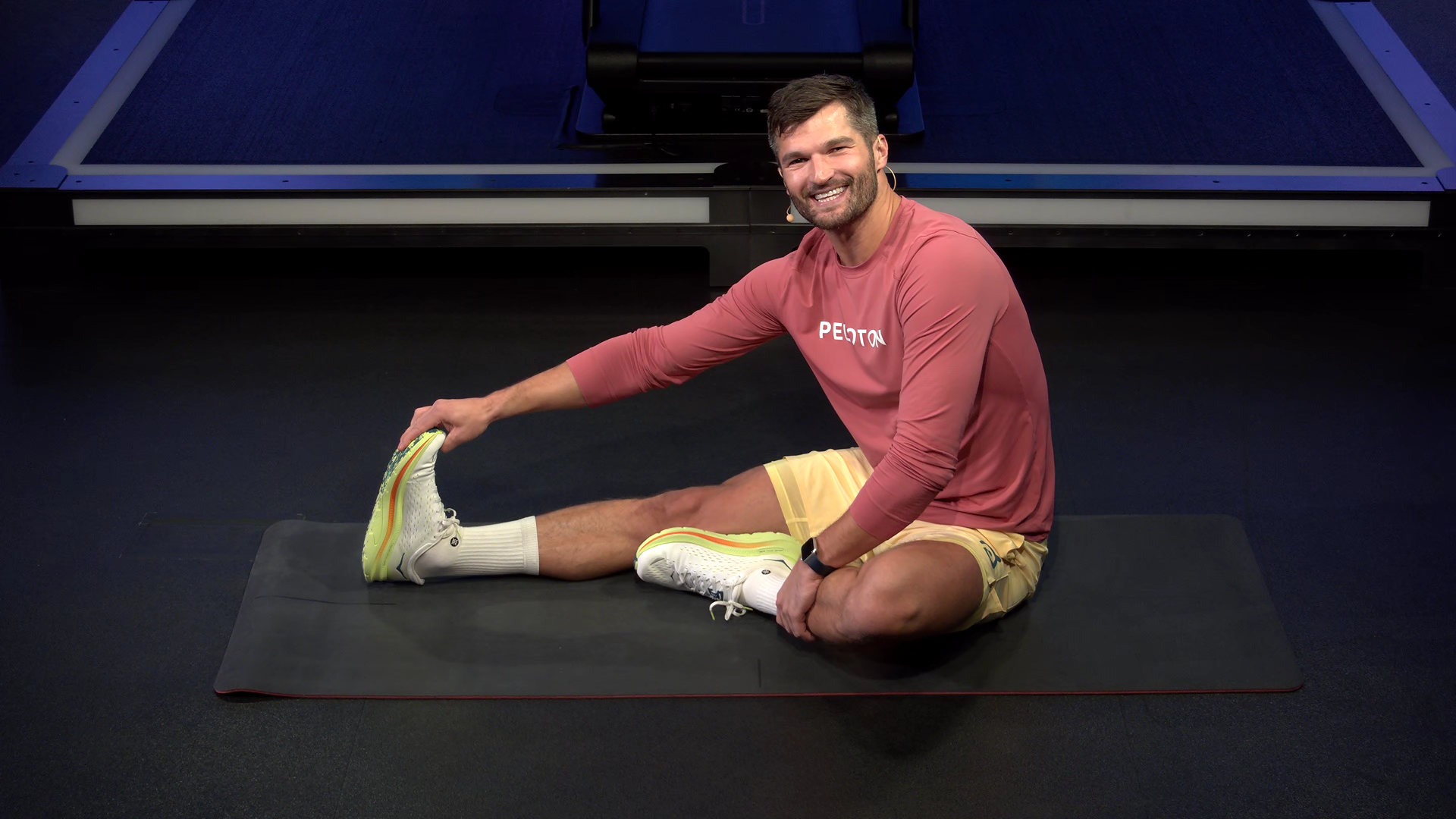
What You Need to Know About Static Stretching—and When to Do It
A beginner’s guide to integrating it into your routine and five moves to start with.
By Emily Laurence, Sarah Klein•
What Is Static Stretching?
11 Static Stretches to Try
How Stretching Affects Fitness Performance
When Is the Best Time to Do Static Stretching?
How Long Should You Hold A Stretch?
Tips for Integrating More Stretching Into Your Workout Routine
The Takeaway
When it comes to working out, most people look forward to the part that gets their heart pumping. For you, maybe it’s clipping into your Peloton Bike and getting an early morning ride in. Or maybe you like getting lost in a long run out in nature. While stretching may not be your favorite part of working out, it’s still a critical piece of your overall fitness routine.
The most important kind of stretching to do after your workout of choice is called static stretching. In order to reap the maximum benefits of stretching, it’s important to know how static stretches differ from dynamic stretches, the specific benefits of static stretching, and when the best time to do static stretching is.
What Is Static Stretching?
Static stretching involves holding a specific position for a certain length of time without moving. When the muscle is held in an elongated position, the muscle relaxes and lengthens, leading to an increase in stretch tolerance and a decrease in muscle stiffness. This helps relieve muscle tension and increase flexibility and range of motion in the muscle you’re stretching, says Ashley Kumar, a physical therapist at Palm Health.
Because static stretching can feel a little boring sometimes—you’re just holding that same position, after all—it’s not always easy to find the time to commit to a solid static stretching routine, says Peloton instructor Jon Hosking. “But for me, it represents the final piece of the puzzle.”
There’s a place in your routine for both static and dynamic stretching when done correctly and at the right time.
The Difference Between Static and Dynamic Stretching
Dynamic stretching, on the other hand, involves moving through a full range of motion. While both static stretching and dynamic stretching are important, they serve different purposes.
“Dynamic stretching is typically done before a workout as a way to warm up the body,” Kumar says. “It’s a way to prepare your joints and muscles for activity, so the dynamic stretches done before a workout mimic the activity you’re about to do.”
For example, if you’re about to go for a long run, you may warm up by doing butt kicks and high knees, two dynamic stretches that utilize the same muscles as running. Kumar says dynamic stretches like these help reduce muscle stiffness by improving range of motion.
This is different from static stretching, where you hold a position for a period of time, typically between 30 and 90 seconds. Instead of a warm-up, static stretching is best used as a cooldown. When your muscles are already warmed up from physical activity, it’s easier to hold static stretches. “The benefit of static stretching is that it helps improve flexibility and reduce recovery time,” Kumar says. Research backs this up: Holding a stretch for just 10 to 30 seconds can help increase flexibility.
Another benefit of static stretching is that it can help improve posture, Jon says. This is because it can undo some of the effects of sitting for a prolonged amount of time on muscles and joints, which can create muscle imbalances in the body.

Peloton App
Access thousands of classes with no equipment needed.
11 Static Stretches to Try
Knowing the benefits of static stretching is important, but you aren’t going to reap any of the rewards unless you know how to do it. Below are 11 moves recommended by Kumar and Peloton instructor Erik Jäger.
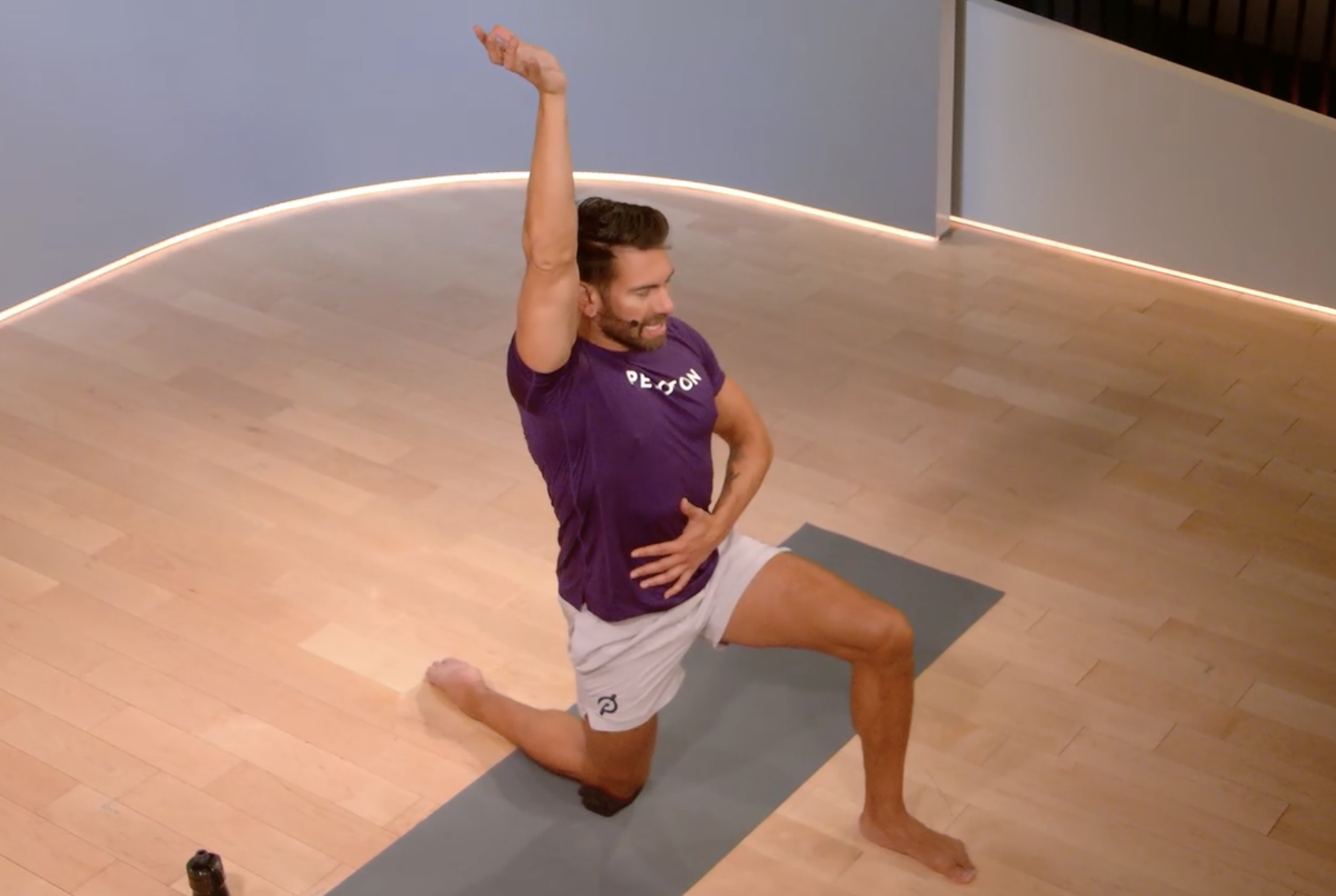
1. Hip Flexor Stretch
“The hip flexor stretch is extremely important to do if you sit all day or live a sedentary lifestyle,” Kumar says. It helps improve mobility in the hips and lower back.
1. Kneel on the floor on your left knee. Bend your right knee at 90 degrees with your right foot planted in front of you.
2. Shift your weight forward. You should feel the stretch in your left hip and thigh.
3. Hold for 30 seconds. Then, switch legs.
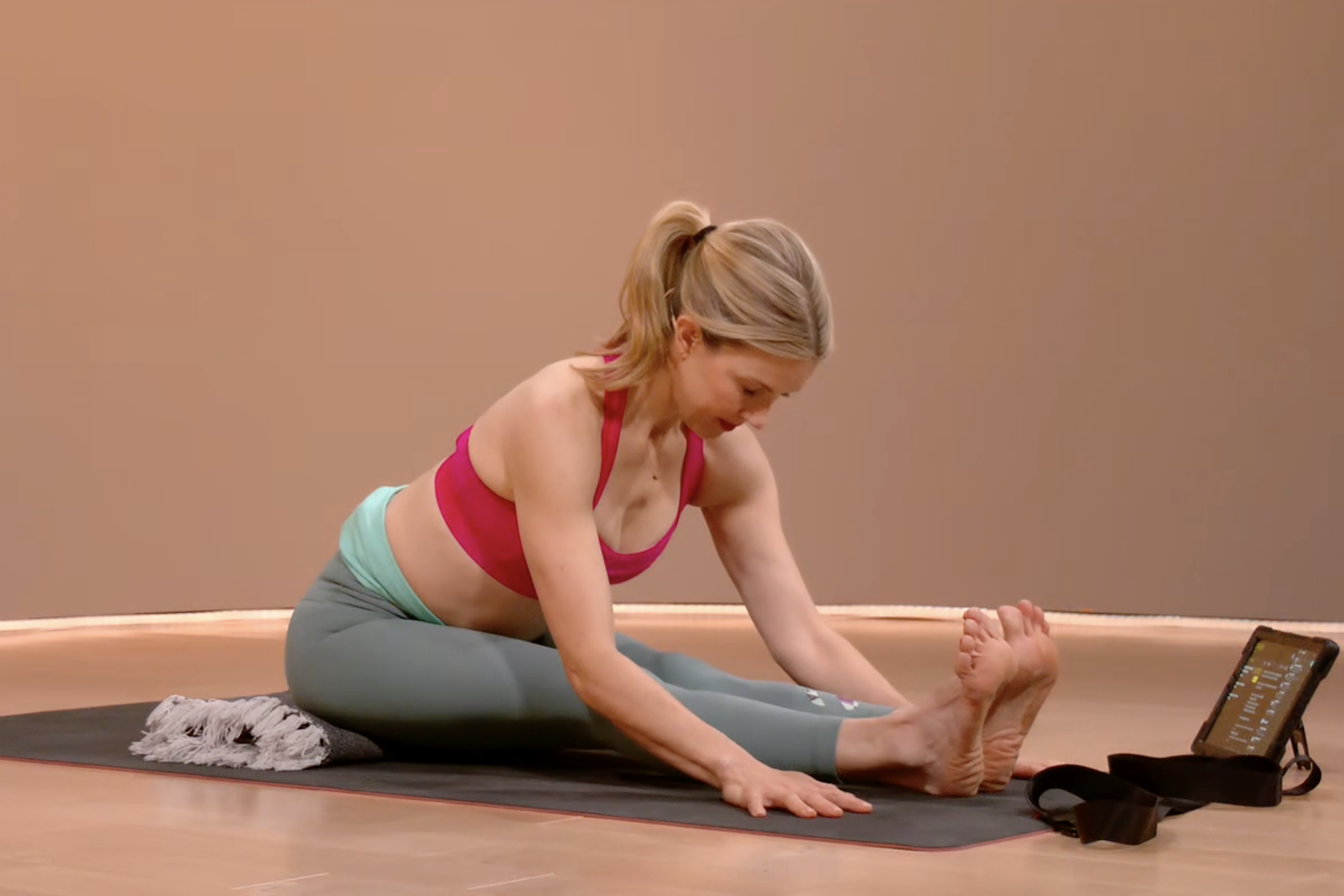
2. Hamstring Stretch
There’s a good chance your hamstrings are tight, especially if you’re a runner or a cyclist. Show the backs of your legs some love with this stretch, which helps relieve soreness.
1. Sit on the floor with your legs extended out in front of you.
2. Reach forward and try to touch your toes. If your toes are out of reach, place your hands around your shins or ankles instead.
3. Hold for between 30 and 60 seconds.
3. Pectoral Stretch With Door Frame
For a static stretch that targets the upper chest, Kumar recommends a pectoral stretch. This one can be done in a doorway and can help undo the damage of hunching in front of a computer or over your phone.
1. Stand in a doorway, stepping one foot forward.
2. Raise your arms up and bend your elbows at 90 degrees. Lean your forearms on the sides of the doorframe.
3. Gently push your chest forward, leaning into the stretch. Hold for between 30 and 60 seconds.
4. Lat Stretch With Door Frame
While you’re still near a doorway, try this stretch for the latissimus dorsi muscles on the sides of your back and your shoulders, Erik says.
1. Grab onto a door frame or doorway edge with your right hand.
2. Let your hips sink back and lean away from the grip, creating a stretch along the right side of your torso.
3. Use your left hand to reach across your body and rotate your upper torso gently toward the floor or opposite knee. You should feel a deep stretch along your side and back.
4. Hold for 45 to 60 seconds (or longer if comfortable), then repeat on the other side.

5. Upper Trap Neck Stretch
Feel tightness in your neck? If you spend a lot of time at the computer or using your phone, there’s a good chance you do. Kumar says an upper trap neck stretch can help relieve this tension, as well as improve posture and shoulder mobility.
1. Sit or stand up straight. Maintain a neutral spine.
2. Place your left hand on top of your head, gently applying pressure as you tilt your head toward your left shoulder.
3. Hold the stretch for 30 seconds. Remember to keep breathing while you hold this stretch. Gently release the stretch and repeat on the other side.

6. Overhead Side Stretch
An estimated 75 to 85 percent of Americans will experience back pain at some point in their lives. Doing static stretches that target your quadratus lumborum (a muscle located in your back, running from your pelvis to your bottom rib on the sides of the spine) can help ease pain now and prevent it in the future. This is one of Kumar’s favorite static stretches targeting the back.
1. Stand up straight and reach your arms overhead.
2. Tilt to one side, feeling the stretch all the way through your hips and arms.
3. Hold for 30 seconds. Repeat, reaching your arms to the other side.

7. Forearm Stretch on All Fours
You may not realize how important it is to stretch the small muscles in your wrists and forearms. But especially if you type on a computer or use your phone a lot, this gentle movement can bring serious relief.
1. Start on your hands and knees on the floor.
2. Rotate both hands so your fingertips point toward your knees.
3. Keep your elbow slightly bent to avoid overextension.
4. Very slowly start shifting your weight back toward your heels. Stop when you feel a gentle stretch along the underside of your forearm.
5. Breathe deeply and hold this position for at least 45 seconds, gradually increasing if it's comfortable.

8. Seated Adductor Stretch
Also sometimes called the butterfly stretch, this movement targets your inner thighs and hips, Erik says.
1. Sit upright on the floor.
2. Bring the soles of your feet together in front of you, pulling them in as close to your body as is comfortable.
3. Sit tall with your spine straight and core gently engaged.
4. Let your knees fall toward the floor naturally (no need to press them down).
5. Hold for at least 60 seconds, focusing on releasing tension with each exhale.
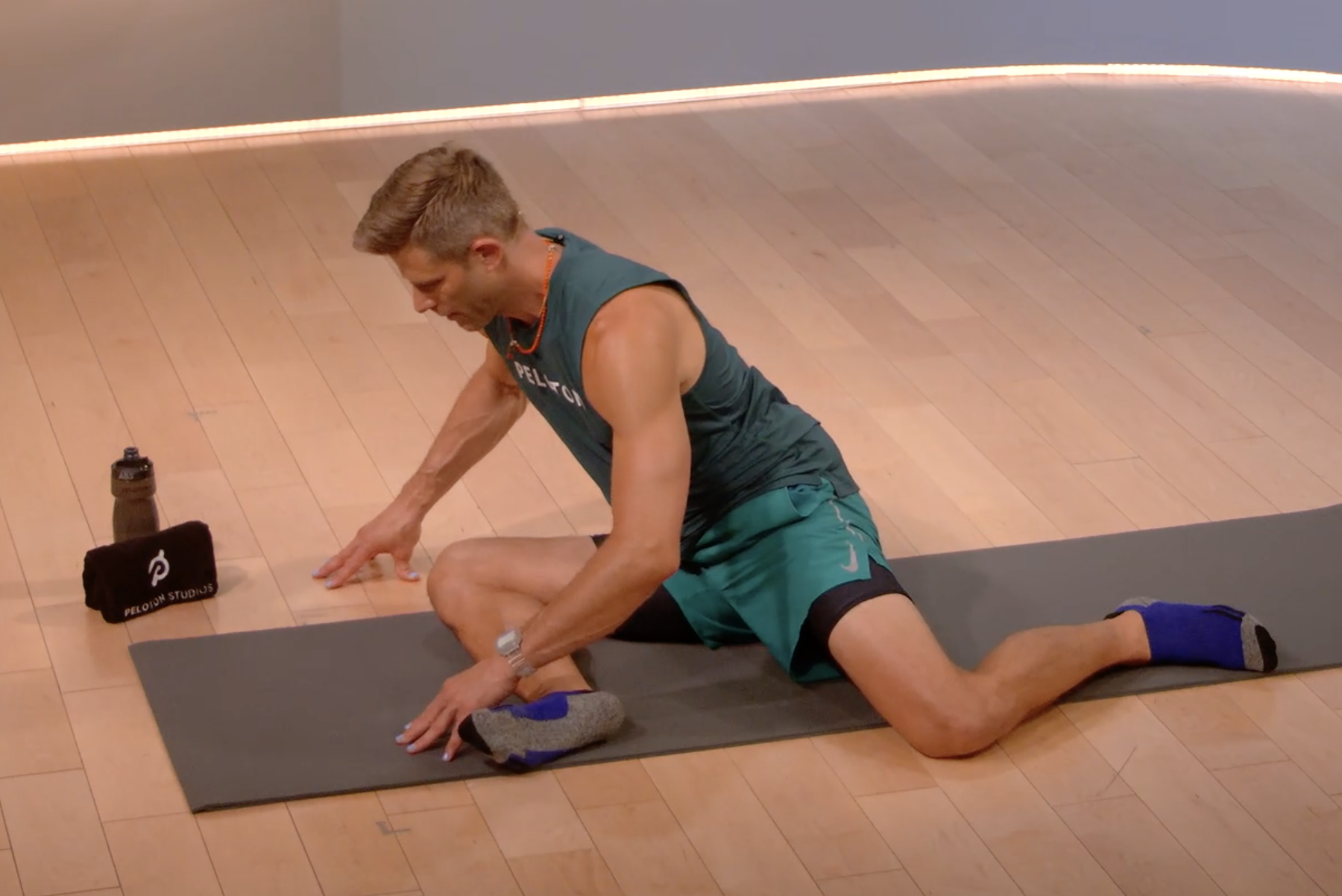
9. 90/90 Stretch
Anyone who spends significant time seated can benefit from the 90/90 stretch, which eases tight hip abductors and improves hip mobility, Erik says.
1. Sit on the floor with your right leg in front of you, bent at 90 degrees at the knee.
2. Position your left leg out to the side, also bent at 90 degrees.
3. Rotate your torso so your chest is facing over your right shin.
4. Keep a straight spine and slowly hinge forward from your hips.
5. Inhale to lengthen the spine, and exhale to deepen the fold.
6. Hold for 45 to 60 seconds, then switch to the other side.
10. Calf Stretch With Door Frame
Focus on the gastrocnemius and soleus muscles on the backs of your lower legs with the traditional calf stretch. All you need is a door frame, wall, or other sturdy vertical surface. “You can adjust the intensity by moving your foot closer to or farther from the surface,” Erik says.
1. Place the toes of one foot up against a door frame, wall, or vertical surface with your heel resting on the floor.
2. Step the other leg slightly behind you.
3. Slowly lean forward, pressing your hips toward the wall while keeping your back leg straight. Keep your chest lifted and spine long.
4. Hold for 45 to 60 seconds, then switch sides.

11. Side-Lying Quad Stretch
The large muscles on the fronts of your thighs, called your quadriceps, power forward motion like cycling and running. Take away some of that tension with this quad stretch. “If reaching your foot is difficult, use a towel or strap looped around the ankle,” Erik says.
1. Lie on one side, with your legs stacked.
2. Bend your top leg toward your glutes. Gently grab that ankle or foot with your top hand.
3. Slowly pull your heel toward your glutes to stretch the front of your thigh. Keep your hips aligned and stacked (don't let your top hip roll backward). You can place a pillow or other support under your head for comfort.
4. Hold for 45 to 60 seconds, then switch sides.
How Stretching Affects Fitness Performance
Static stretching can help with flexibility and recovery, but can it make you a better athlete? While the benefits are small, research suggests regular static stretching could lead to better muscle strength and power. A smaller, older study found static stretching led to improved athletic performance in exercises that involved flexibility, jumping, sprinting, and endurance.
“Static stretching increases blood flow and improves range of motion,” Kumar says. This helps protect against wear and tear during exercise. And when your muscles and joints have a wider range of motion, you can move more easily during exercise, giving you a competitive edge, she adds.
That also means you’ll be able to move more easily throughout your day-to-day life, which can help you stay agile and independent as you age and potentially avoid injury.
Of course, stretching reduces muscle stiffness, and when your muscles are feeling good, you may be more inclined to stick with your workout routine, leading to improvements in performance over time.
Static stretching also feels really, really good after working out—a benefit not to overlook. “It’s a great moment to relax, ground yourself, and take stock of your performance after a workout,” Jon says. Similar to enjoying a few moments in Child’s Pose or Savasana at the end of a yoga class, you’ll start looking forward to the ritual of rewarding your body with static stretching after a hard workout.
When Is the Best Time to Do Static Stretching?
Both Kumar and Jon say the best time to do static stretching is after working out—and even just a few minutes is enough. “Whether it’s after a heavy weightlifting session, soccer game, basketball game, or another type of workout, it’s beneficial to do some static stretching,” Kumar says.
The goal, Jon adds, “is to either maintain or increase your level of flexibility and range of motion, and ideally this is done after a workout when your muscles are warmed up and more supple.”
How Long Should You Hold A Stretch?
How long to hold a stretch depends on your goal. Do you want to actually lengthen your muscles or just maintain their current state? “Maintenance stretching should involve holding a stretch for between 10 and 15 seconds, whereas developmental stretches should be held for more than 30 seconds in order to deepen the stretch and extend the length of your muscles,” Jonhe says. “Over time this will aid you in how easy you move, prevent the risk of injury, and help to correct any postural imbalances you may have.”
Tips for Integrating More Stretching Into Your Workout Routine
When Jon moves through static stretches, he says he likes to focus on his spine first, to help with overall range of motion. Next, he hits all the major muscles in his legs. He likes to finish static stretching with moves that require lying down. “I find [lying down stretches] to be the most relaxing because I don’t have to focus much on balance and coordination,” he says.
Most importantly, be mindful of what your body needs, Kumar says. If you feel tightness in a specific area, that’s your body telling you it could benefit from a static stretch that targets those particular muscles. She also says it’s important to avoid overstretching, which can lead to hypermobility and increase the risk of injury.
The Takeaway
Static stretching is one of the two most common types of stretching. It involves holding a specific position for a set period of time to lengthen your muscles, leading to improvements in flexibility, posture, and performance. It’s best reserved for after physical activity when your muscles are already warm. Hold static stretches for between 10 to 30 seconds. You can start with some of the suggestions above, follow along with a stretching class on the Peloton App, or stretch in any other way that feels right for you.
This content is for informational and educational purposes only and does not constitute individualized advice. It is not intended to replace professional medical evaluation, diagnosis, or treatment. Seek the advice of your physician for questions you may have regarding your health or a medical condition. If you are having a medical emergency, call your physician or 911 immediately.
Level up your inbox.
Subscribe for a weekly dose of fitness, plus the latest promos, launches, and events.
By providing your email address, you agree to receive marketing communications from Peloton.
For more about how we use your information, see our Privacy Policy.
